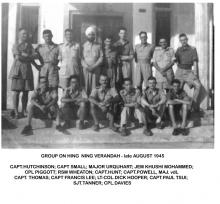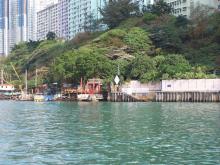Osler THOMAS (aka BAAG No. 44 / BAAG No. 74 (?) / 譚藹勵) [????-????]
Primary tabs
Submitted by Admin on Tue, 2013-11-12 18:43
Sex:
Male
Status:
Deceased
Tags:
Connections:
- Osler THOMAS (aka BAAG No. 44 / BAAG No. 74 (?) / 譚藹勵) [????-????] child of Nora THOMAS (née GOURDIN) [????-????]
- Osler THOMAS (aka BAAG No. 44 / BAAG No. 74 (?) / 譚藹勵) [????-????] child of George Harold THOMAS [1889-1975]




Comments
Osler Thomas
Dr. Osler Thomas Chinese name was 譚藹勵. He joined the BAAG AHQ at Wai Chow in November 1942 as an Assistant Medical Officer and also took active part in field operations. He assumed the No.44 when reporting intelligence. He was awarded an MBE for his service and promoted to Captain. He became a Surgeon after the War and immigrated to Australia.
Olser Thomas was a medical student of HKU in 1941. He was 19. He joined the Field Ambulance before the Japanese invasion and held the rank of Leutenant. During the battle, he was at Shaukeiwan with teh British & Canadian defenders when the Japanese troop masacred wounded soldiers in the medical post and was about to execute by beyonets all others up the hill behind Salesian School. Osler was amongst the group when one soldier ran off and Osler dropped himself into the catchment nullah feigning death. He later made good his escape albeit with some injuries.
He made his way to AHQ Waichow eventually with other HKU students and joined the BAAG as an Assistant MO. At times, he served as interpretor for the liaison of the BAAG AHQ with the commanders of the local Chinese garrison.
Apart from manning Forward Medical Posts such as the ones at Lam Tong & possibly Tam Uk and Shek Ma, Osler also played active role in field operations such as manning Post Y at Chek Keng Saikung from time-to-time during the absence of Francis LEE Yiu-piu. Since Chek Keng was also a Post of the Communist Kong Kau Guerrillas, he also taught them first aid and treating their wounded.
Osler Thomas played a part in aiding Ronald Holmes during the negotiation with the Communist Guerrillas in the FRIGATE BIRD incident. Francis Lee & his team were captured and held for ransom by the Communist Guerrilas when they were setting up an Observation Post for enemy shipping at Koling, Dapeng Bay. The Post was approved by the Nationalist Government authorities but not the Communist Guerrillas. Osler was known to the Marine Guerrillas under Lau Pui, because he used their junk service shuttling between Post X at Shayuchung and Post Y Saikung.
He had given me copies of his passes from both the Government & Communist authorities (signed by Fong Kwok-wan 2 1/c of the Guerrillas). He was also very keen on the maps he used, and tracked the walking distances between different towns & villages in the Wai Tung area.
There is a difference in the
There is a difference in the BAAG number associated with Osler Thomas. Lawrence has noted number 44, while Elizabeth has noted 74.
Osler Thomas, BAAG.
From the entry for Osler Thomas in the BAAG Personnel Register, Ride Collection:
“This officer served during the hostilities in Hongkong as a Cadet Medical Officer in the HKVDC Field ambulance. He was captured by the Japanese at Shaukiwan and was one of the three survivors of the massacre of the RAMC and Field Ambulance personnel who were taken prisoner at his post. He lay all day under the dead bodies of some of his men, and at night fall made his escape. He could not return to his HQs, so remained in concealment until after the surrender when he escaped to Free China. There, being a member of the HKVDC, he was immediately demobilised and instead of continuing with his medical studies he elected to serve with the BAAG which he did in a civilian capacity until he was commissioned by Force 136 in March 1944.
In 1943 Lt. Thomas in conjunction with Lieut. Lee established a BAAG post in the New Territories at Saikung about 4 miles from the Kowloon P/W Camps. This post was maintained for about 6 months when it had to be abandoned owing to political complications with the Reds.
From this post contacts with Kowloon and Hongkong were made and maintained for E & E and Intelligence purposes and the villagers in the whole area briefed on escape and evasion duties with the result that later on an American evader and a number of civilians were brought out to safety from under the very noses of the Japanese. It was impossible to supply this post with W/T and hence all important information had to be brought out by runners. A number of times Lieut Thomas himself had to make this hazardous journey across the enemy held New Territories and Mirs Bay. Twice he was forced to land on Tap Mun Chau Island, a veritable nest of Japanese and bandits. In each case he came through successfully with important information and delivered it safely to AHQ Waichow.
Later in the same year when our post at Taipang Peninsula was captured by the Reds, Lieut Thomas took part in the negotiations for their release and in order to carry out this work he had to spend much time in unprotected areas.
From May 1945 till the cessation of hostilities, Lieut Thomas was in charge of our forward intelligence post and was liaison officer with Chinese Military HQs at Koochuk on the East River. This was an isolated post of great responsibility requiring tact in dealing with the Chinese and initiative and judgement in making decisions when reference to higher authority was impossible. Lieut Thomas carried out the duties of this post with most commendable skill.
Practically the whole of his service was in the forward areas. Lieut Thomas showed a high standard of sense of duty and invariably carried out his missions with complete disregard for his own comfort or safety.” (signed) L T Ride, Colonel. 1946.
Osler Thomas
THE SALESIAN MISSION. Sworn Statement to War Crimes Commission by Osler Thomas, Field Ambulance, HKVDC
On 8th December 1941 hostilities broke out in Hong Kong and a few days later, as Cadet Medical Officer in the Field Ambulance, Hong Kong Volunteer Defence Corps, I was posted as Medical Officer to the 3rd Battery, HKVDC at Pak Sha Wan, Lyemun. Due to very heavy Japanese shell fire, I was later sent back to our Advance Dressing Station situated at the Salesian Mission, Shaukiwan. The ADS was commanded by Captain Stanley M. Banfill, Royal Rifles of Canada, and the personnel comprised a number of medical orderlies from the same Regiment. The building also housed RAMC supplies and stores in charge of QMS Buchan and a number of RAMC other Ranks, together with a civilian Red Cross Aid Post under Dr. Orloff. His staff consisted of another Chinese doctor, Dr. Tsang Fook Chor, St. John’s Ambulance stretcher-bearers and some ANS nurses.
At about 0600 hours on 19th December 1941, being unaware of the fact that the enemy had actually landed and were in the vicinity, I left the ADS with an ambulance carrying 2 wounded Rajput Officers (British Captains) and an injured civilian. We had only gone a few yards up the road when the ambulance was raked by intense machine-gun fire. The driver and an orderly (both Canadians) leapt from the ambulance and one was hit in the leg. I backed the vehicle down the road to the Mission and managed to get into the building to warn the rest of the personnel. They went up to the top floor of the building and from there they could see large numbers of Japanese on the hill-side above. In a few minutes the building was surrounded and the glass doors of the basement were broken in. Owing to the presence of women and civilians and the overwhelming numbers of the enemy, the post surrendered.
All the personnel, including Chinese cooks and servants, were led out onto the level ground in front of the building, and all the males searched and stripped except for their trousers. After about an hour, we were all led on to the main road and the women taken up towards Lyemun Barracks while the men were led up the hill behind the Mission. On the main road we saw the 2 Rajput Captains lying by the roadside after having been thrown out of the Ambulance. The men were then lined up on the edge of the nullah which runs behind the Mission, with a large number of Japanese troops on the hillside watching on. Suddenly three Japanese soldiers started to bayonet our unsuspecting men from the rear amidst cheers from the enemy onlookers. Some of our men had to be bayoneted three times before they would fall and then their bodies were kicked into the nullah. I think at this moment panic must have broken loose as a number of those on the lower end of the line broke and ran and these were shot. These included Dr. Orloff. During this pandemonium of shooting I fell into the nullah as though shot, the bodies of two victims later falling on me and protecting me from the orgy of shooting and bayoneting that followed.
I lay in that bloody nullah all day, hearing the groans of the dying and seeing the flow of blood under me, but not daring to move. One RAMC cook, badly wounded in the neck crawled over me down the nullah and I advised him to lie still, but this advice he ignored. That night, I escaped down the nullah but was unable to get through the Japanese lines and so, after obtaining Chinese clothes, lived in an ARP shelter and later in a hill-squatters hut until about the 23rd December, when dysentery and general weakness forced me to make my way to Causeway Bay where I sheltered with a friend who put me up and took care of me until after January 1942 when I returned to my home. I left Hong Kong for Free China in July, 1942.